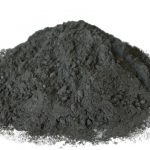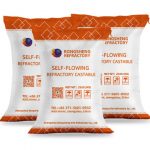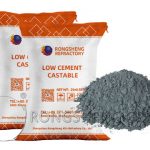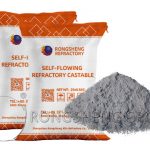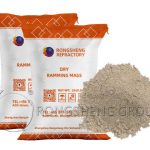Preparation for construction. In accordance with the design size requirements, check and accept the construction quality of the previous process and clean up the site. Transport the forced mixer, insert vibrator (vibrator) and trolley and other machinery to the site, install them in place, and test run them normally. It should be pointed out that the mixer must be forced, the vibrator should be high-frequency, and there must be enough spare parts. The formwork should have sufficient strength and rigidity and be transported to the site in a timely manner; the lighting power supply should be turned on, and clean water should be connected to the front of the mixer. Refractory castables are generally bagged, and materials such as anchor bricks, connectors, insulating refractory bricks, calcium silicate boards, refractory fiber felts, asbestos boards, refractory clay bricks, and burner bricks should be transported to the site at any time as required. When using chemical binders, their concentration or density should be adjusted in advance and transported to the site for use. Before use, it should be re-stirred evenly.

Verification of Construction Mix Proportion
Before construction, bagged refractory castables and their admixtures should be sampled and tested according to the design drawings or the manufacturer’s instructions, and their main properties should be verified. If the refractory castable fails to meet design requirements, the material should be replaced as soon as possible; this is crucial. Therefore, this work is very important, and attention should be paid to its performance indicators from the time the refractory castable is purchased. For qualified products, the on-site construction mix proportion should be determined based on site conditions and the material’s storage time.
Insulation Layer Construction and Formwork
For refractory castable vibration construction, this work also falls under construction preparation. Before constructing the refractory castable furnace wall, firstly, ceramic fiber boards are laid, metal connectors are installed, and anchor bricks are placed. Second, insulating refractory bricks are laid, or lightweight refractory castable is poured. Third, formwork is erected. The working surface of the formwork is first coated with oil or paper, then pressed tightly against the working end face of the anchor bricks for support. Each formwork erection should be 600-1000mm high to facilitate material loading and vibration molding. When a formwork template is available, it should be erected first, followed by the formwork. A plastic film should be applied to the surface of the insulation layer to prevent water absorption and its impact on the performance of the castable. When the furnace wall is high, the insulation layer should be constructed in layers to prevent it from collapsing during casting vibration.
During the construction of the refractory castable furnace roof, the entire formwork should be firmly erected according to the design dimensions. Then, oil should be applied, and the hanging bricks should be suspended from the hanging beams using metal connectors. Some connectors require wooden wedges to secure the hanging bricks, while others do not. The hanging bricks should be installed perpendicular to the furnace lining working surface, with a bottom face distance of 0-10mm from the formwork surface. More than 60% of the hanging brick ends should be in contact with the formwork surface. If the distance exceeds 10mm, the metal connectors should be adjusted to meet the requirements. When there are holes, the mold should be installed firmly before the template is erected.
Mixing
Forced mixing should be used. For smaller quantities, manual mixing is also acceptable. The mixing process varies depending on the type of refractory castable. For bagged materials or refractory aggregates and cement, the allowable error is ±1.0%; for additives, ±0.5%; and for water and liquid binders, ±0.5%. The dosage of additives must be accurate. All raw materials must be weighed and added to the mixer without omission or over-addition.
For cement-based, clay-bonded, and low-cement refractory castables: First, dry bulk materials such as bagged materials, additives, and other additives should be added to the mixer and dry-mixed for 1.0 minute. After uniform mixing, water should be added and wet-mixed for 3-5 minutes until the material color is uniform before discharging. Then, it should be transported to the working face for distribution. For water glass refractory castables, it is best to first dry-mix the refractory granules in the mixer, then add the water glass solution for wet mixing. After the granules are coated with water glass, add refractory powder and other materials, and wet mix for about 5 minutes. Then, discharge the material for later use. If the dry materials are mixed together, pour them into a mixer and dry mix for 1.0 minute, add 2/3 of the water glass solution and wet mix for 2-3 minutes, then add the remaining binder and wet mix for 2-3 minutes. The material is then ready for use. The mixing of resin-bonded carbonaceous refractory castables is similar.
For mixing refractory castables such as phosphoric acid and phosphates, first pour the dry materials into a mixer and dry mix for 1.0 minute, then add about 3/5 of the binder and wet mix for 2-3 minutes before discharging. Transport the material to a designated location, cover it tightly with plastic film, and allow it to settle for at least 16 hours. Weigh the settled material and accelerator, pour them into a mixer for a second mixing, and add the remaining binder and wet mix for 2-4 minutes. The material is then ready for use.
When mixing refractory castables, if heat-resistant steel fibers, refractory fibers, and organic fibers need to be added, they should be continuously and continuously sprinkled into the mixer during the wet mixing process. Sprinkle and mix simultaneously, and never add in clumps. If the mixture is too dry, too thin, or lacks a certain material after exiting the mixer, it should be discarded and not reused. The mixture exiting the mixer should be used within 0.5–1.0 hours. Any material that has initially set and hardened should be discarded.
Vibration Molding
The mixed material should be transported to the construction site promptly. When pouring the furnace bottom, the material thickness should be approximately 200mm. Then, vibrate with a plate vibrator. If using a vibratory rod, the material thickness should be 200-400mm. When constructing the furnace wall, lay the material from one end or at the expansion joint, with a thickness of 300-400mm. After laying the material, vibrate immediately with a vibratory rod, and vibrate continuously while laying the material. The formwork should also be continuously erected. Where expansion joints are encountered, expansion joint material should be added, and the design requirements should be maintained.
When using a vibratory molding machine, the plate vibrator should be moved continuously, and the edges of the plate should overlap to prevent missed vibration. When using a vibratory rod, it should be inserted slowly into the material layer, moved continuously, and withdrawn slowly to prevent leaving holes and missed vibration. The vibratory rod must not collide with the formwork, anchors, or insulation layer. The vibratory rod should ideally be kept 100-120mm away from the formwork and wall. The lining generally requires at least two consecutive vibrations until surface slurry returns, venting is minimal, and settling ceases.
Construction of the furnace roof lining also begins at the end, with a typical thickness of 250-300 mm. The vibrator moves along the furnace length and width between the hanging bricks, avoiding collisions. Construction can only continue forward when slurry returns to the surface and the designed thickness is reached. During construction, expansion joint material and temperature measurement hole formwork should be applied. Once the entire furnace roof lining is completed, the insulation layer can be applied. However, metal connectors for the hanging bricks must not be embedded within them. When the entire refractory castable lining is completed and has initially set and gained strength, the formwork can be removed, and the site cleaned. Simultaneously, curing should be performed according to the requirements of the refractory castable type.


